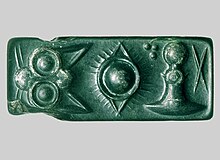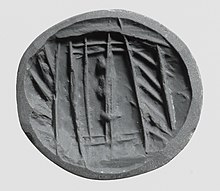Minoan seals
They are an important part of Minoan art, and have been found in quantity at specific sites, for example in Knossos, Malia and Phaistos.[3] A seal-carving workshop from MM I excavated at Malia mostly made this type; here, as throughout the surviving seals, there are wide variations in the quality of the carving.[8] The Pylos Combat Agate is an exceptionally fine engraved gem, probably made in the Late Minoan, but found in a Mycenaean context.[12] In a large group of sealings from the palace at Phaistos that seem to be early MM II, or around 1800 BC, over two thirds of the nearly 300 designs abstract patterns, some very simple, but others complicated and sophisticated.For Sinclair Hood, these objects (specifically those from Circle A) "raise in an acute form the related questions of how to distinguish mainland from Cretan work, and the significance of any distinction that may exist".[20] It does not seem that seals were actually used for making impressions on the Greek mainland at this point, so these objects, usually thought to be of Minoan workmanship, were apparently treated as jewellery for women.[21] The tholos or beehive tomb at Vaphio (or Vapheio) near Sparta is another famous find that has generated much discussion as to the origin of many pieces; the two gold cups are now usually thought to be Cretan in the case of one, and the other Mycenaen, made to match.



signet ringAshmolean Museumimpression sealscarved gemstonesMinoan civilizationMinoan artKnossosPhaistosscaraboid sealsAncient EgyptCylinder sealslentoidjasperCretan hieroglyphsengraved gemssignet ringsTheseus RingAthensintaglioPylos Combat Agateengraved gemAegean SeaMinoan hieroglyphsgriffinsphinxMinoan Geniusgoddessesiconographicfrescoesbull-leapingconfrontedMinoan paintingtalismanicamuletsZakrosMycenaeshaft gravegrave goodsSinclair HoodGrave Circle Abeehive tombVaphioSpartacharm braceletGriffin Warrior Tombstamp sealsCeram, C.W.Richard and Clara WinstonHood, SinclairMinoan chronologyMinoan potteryMinoan palacesMinoan religionMinoan eruptionPeak sanctuariesGalatasHagia TriadaKommosPalaikastroKydoniaGourniaTroullosTrypitiLakkosAmnisosPetrasMonastirakiVasilikiVathypetroZominthosArmeniApesokariChryssolakkosKamilariKoumasaNea RoumataOdigitriaPhourniPhylakiStylosYerokambosArkalochoriKamaresPsychro CaveAtsipadesMount JuktasPetsofasTraostalosVrysinasAegina TreasureAkrotiri Boxer FrescoHagia Triada SarcophagusHorns of ConsecrationSnake goddess figurinesLa Parisienne (fresco)Lustral basinPrince of the LiliesStirrup jarHarvester VaseKamares wareKoulouraKnossos board gameMinoan frescoes from Tell el-Dab'aMalia altar stoneMalia PendantMinoan Moulds of PalaikastroMinoan Bull-leaperPapoura Hill Circular StructureVasiliki wareWall Paintings of TheraLinear ALinear BPhaistos discArkalochori scriptArthur EvansHeraklion Archaeological MuseumArchaeological Museum of ChaniaArchaeological Museum of Sitia